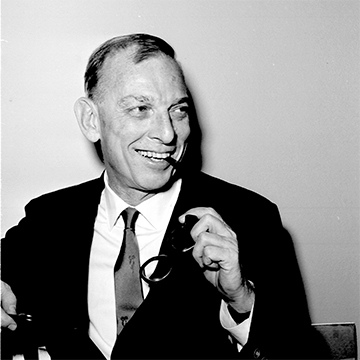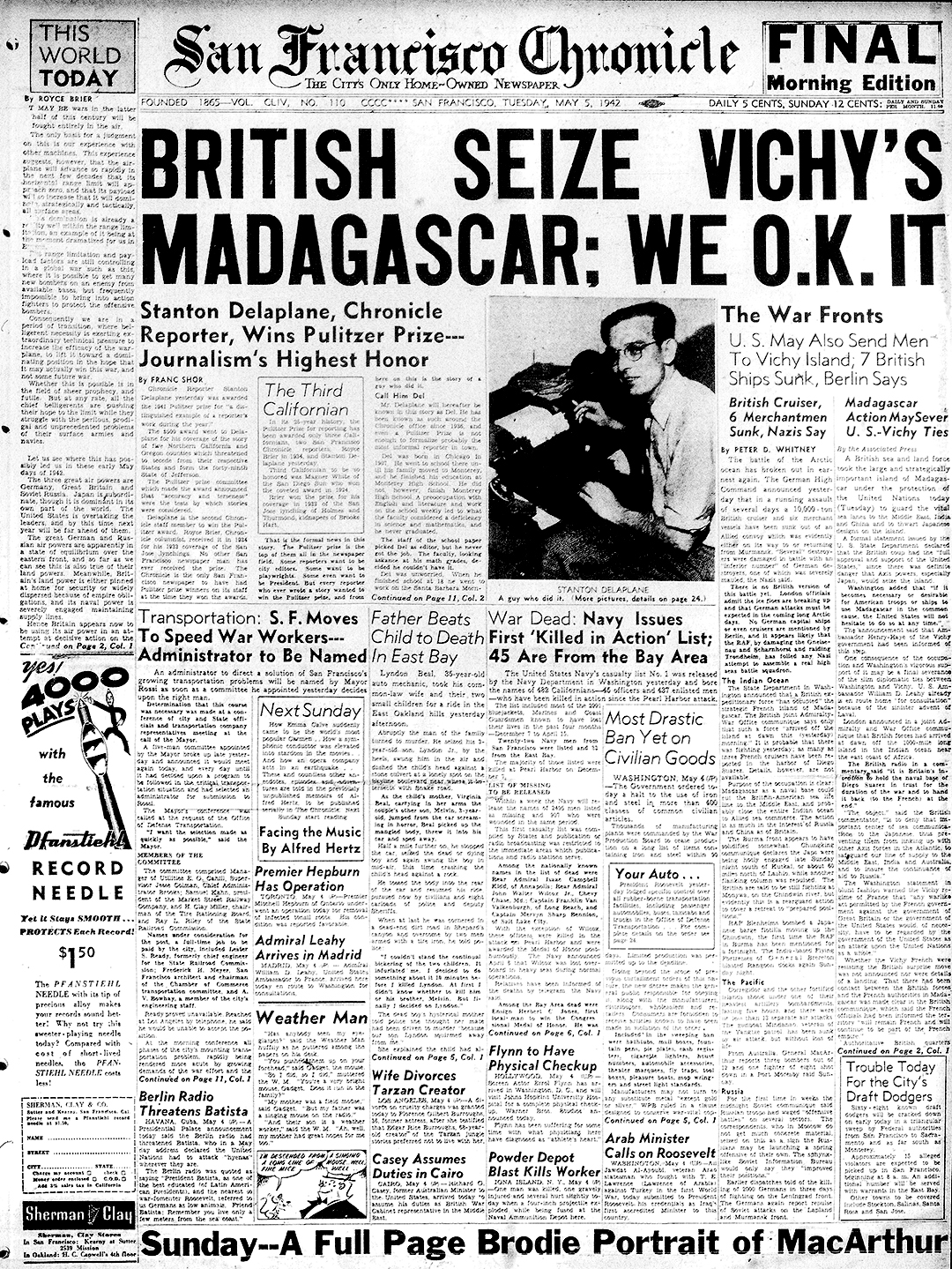
Stanton Delaplane, Chronicle Reporter,
Wins Pulitzer Prize – Journalism’s Highest Honor
By Franc Shor
San Francisco Chronicle
May 5, 1942
Chronicle Reporter Stanton Delaphlane yesterday was awarded the 1941 Pulitzer prize for “a distinguished example of a reporter’s work during the year.”
The $500 award went to Delaplane for his coverage of the story of two Northern California and Oregon counties which threatened to secede from their respective states and form the forty-ninth State of Jefferson.
The Pulitzer prize committee which made the award announced that “accuracy and terseness” were the tests by which stories were considered.
Delaplane is the second Chronicle staff member to win the Pulitzer award. Royce Brier, Chronicle columnist, received it in 1934 for his 1933 coverage of the San Jose lynchings. No other San Francisco newspaper man has ever received the prize. The Chronicle is the only San Francisco newspaper to have had Pulitzer prize winners on its staff at the time they won the awards.
That is the formal news in this story. The Pulitzer prize is the top of them all in the newspaper field. Some reporters want to be city editors. Some want to be playwrights. Some even want to be President. But every reporter who ever wrote a story wanted to win the Pulitzer prize, and from here on this is the story of a guy who did it.
Mr. Delaplane will hereafter be known in this story as Del. He has been known as such around the Chronicle office since 1936, and even a Pulitzer Prize is not enough to formalize probably the most informal reporter in town.
Del was born in Chicago in 1907. He went to school there until his family moved to Monterey, and he finished his education at Monterey High School. He did not, however, finish Monterey High School. A preoccupation with English and literature and work on the school weekly led to hwat the faculty considered a deficiency in science and mathematics, and he never graduated.
The staff of the school paper pi8cked Del as editor, but he never got the job. The faculty, looking askance at his math grades, decided he couldn’t have it.
Del was unworried. When he finished school at 18 he went to work on the Santa Barbara Morning Press. A year there took him to the Los Angeles Express, and at 20 he decided he needed a little travel and went to sea.
For a year he sailed as a cadet on the Central American run of the Panama Mail Line. On his twenty-first birthday he got off the ship in San Francisco and came to The Chronicle city room to ask for a job.
He didn’t get it.
Del wasn’t worried. As a matter of fact, there is no recod of the man ever having worried about anything. That may be why, at 34, he looks like a kid in his early twenties.
He went to Carmel and got a job under the great Lincoln Steffens on a little weekly. He added to his income by hitting the adventure and Western magazines regularly. Two years of that and he went to Santa Barbara to edit “Aperitif,” a smart-set magazine published by the Baroness Emily von Romberg. That lasted three years.
As editor of Aperitif Del had the distinction of buying five stories by the now-famous William Saroyan for the somewhat surprising total of $100.
“Saroyan wanted to buy a car and needed money,” Del said. “I offered him $100 cash for five stories. I think he sent me about eight before I found five I wanted.”
In 1936 he decided to try The Chronicle again. He came up during the waterfront strike of that year, and the paper needed men. He got the job – and with it the usual treatment for a beginner in the metropolitan newspaper business.
He rewrote publicity handouts. He was sent out to get pictures of people who jumped out of buildings. He was hired by the day, then, and he did the little jobs so well that he didn’t have a day off for four months. At the end of that time the paper discovered it would be cheaper to put him on the regular pay roll, and the city editor discovered that he was too good to waste on handouts. He became a general assignment man, and a good one.
General assignment reporters don’t usually win Pulitzer prizes. Those usually go to men who specialize in a single field. Del got his because he did a single assignment so well it stood out above the work of men all over the country who spend all their time on a single type of story.
A few months later Del went into This World, The Chronicle’s weekly magazine. For six months he wrote 24,000 works a week. A staff of five men now handle the same job. Then he became editor of the women’s pages. In 1937 he came back to the city staff, and promptly became one of the best reporters in the business.
Even in his spare time Del is busy with newspaper affairs. He’s director of the San Francisco Press Club and editor of the club’s ’42 edition of The Scoop. He was co-author of the club’s recent dramatic presentation, “No Bombs Fell,” a gentle satire on defense complacency.
He was formerly chairman of The Chronicle unit of the American Newspaper Guild. If his wife, Miriam, didn’t enjoy hearing dinner-table conversation about the newspaper business, she’d probably have left him long ago. The guy’s a reporter 24 hours a day.
Del has covered a lot of big stories. He flew to Nevada to write the 1939 story of the wreck of the streamliner City of San Francisco. He flew to Placerville on the De Tristan kidnapping. He has covered murders and court trials and robberies, but Del’s specialty is the unusually story – the story with a twist.
For years he has been writing news stories about animals. Every spring he wrote the groundhog story. If a cat got caught atop a telephone pole, Del wrote about it. He writes now about the doings of the strange creatures who inhabit The Chronicle’s weather box on page one. And every time a new animal came to the zoo, Del interviewed it.
“One thing I hope I get out of this prize,” he said yesterday. “I hope for a while I won’t have to write any more animal stories. Sometimes I don’t think I like animals very well.”
The Chronicle used to have a city editor who knew a cat named Lord Thomas. The C.E. thought Lord Thomas was a good story and for months Del interviewed Lord Thomas regularly.
“I carried that damn cat through every crisis in a feline’s life,” Del said yesterday. “I forget whether Lord Thomas or that city editor got sick of it first, but I was awfully glad when it was over.”
Del was The Chronicle’s “stunt man.” During the fair on Treasure Island he spent a day as a six-year-old boy, visiting every concession on the Island. He rode the merry-go-round and the ferris wheel. He ate peanuts and drank lemonade. He got a stomach ache, but his story of the day brought lot of laughs to Chronicle subscribers.
“The worst assignment I ever had,” he says, “is once I was assigned to go out to the zoo and pick a kangaroo’s pouch. They even took a picture of me doing it.”
What did you find in the pouch, Del?
“GOLF BALLS.”
The Chronicle files also show a picture of Del biting a dog. But he always came back with a good story.
In 1940 and 1941, Del was assigned to the Rice Bowl celebration. Last year he traveled all over the state, promoting the parties and handling the campaign. Even on that assignment he ended up with a freak angle.
In every town where a celebration was held, Dr. Margaret Chung would auction off custard pies. The high bidder was allowed to his Del in the face with his purchase. He’s been hit in the face with a custard pie in every good-sized town from Sacramento to Santa Barbara.
Del is one of the very few newspapermen who have no desire to become the Great American Novelist. He never wrote a book or a play, and he doesn’t want to.
“I want to be a good reporter,” he says. “That’s job enough.”
Del doesn’t need to worry.
He’s probably the only man who ever wrote a Pulitzer Prize story while suffering from starvation. That isn’t a gag, it’s true. Here’s how it happened.
Del arrived in Port Orford, Oregon, late at night on the assignment. He got a little sleep, and went to work early the next morning. He covered the story for three days, traveling from town to town, and on the fourth day he discovered he was almost too weak to walk.
“They told me it was the altitude,” he said. “I went to the doctor, and after examining me he started asking me about what I’d had to eat.”
“I started checking back and discovered I hadn’t had a bite since I got there. I’d been going to luncheons and dinners and taking notes on the speeches, and talking a little myself, and I’d never had time to eat. The doctor told me to eat a steak and go to bed, and I woke up the next morning feeling fine.”
Del wrote seven stories on the secession movement. He got back to the office the day Gilbert Gable, Mayor of Port Orford and sparkplug of the secessionist movement, died. Gable’s death and the war, ended the forty-ninth State dream, but it lived in Del’s articles. Those seven stories, written during a week in which he drove a thousand miles, won’t him the prize.
Del didn’t think his stories were anything special. When he was assigned to the yarn he thought it was just another freak. When he got up north and found it was the real thing he did his customary good job on it. But The Chronicle’s assistant managing editor, Larry Fanning, had to submit the articles to the Pulitzer committee for him. He wouldn’t do it himself.
He was home on the last day of his vacation yesterday when the news came of his prize. They brought him down to the office to take his picture, and he didn’t believe it until he saw the wire stories.
“Of course I wanted it,” he said. “I wanted it more than I’ll ever want anything else in my life. But I never had any idea I could win it, covering freaks. I’m glad this one turned out not to be a freak.”
In case you wonder what a Pulitzer Prize winner thinks about in the first few minutes after he learns of it, here’s a clue. The Associated Press photographer had Del sit down at a typewriter while he took his picture. He told him to type while it was being taken. Del did, and here is exactly what he wrote:
“Now ire ht theim e for all good emnent.”
You’d be nervous, too.

